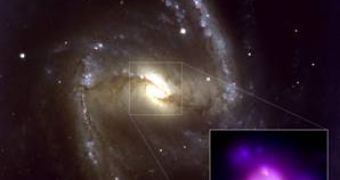Chandra telescope observations of the galaxy NGC 1365, a galaxy located 60 million light-years away have captured a remarkable eclipse of the supermassive black hole at its center. A dense cloud of gas passed in front of the black hole, which blocked high-energy X-rays from material close to the black hole.
Just as eclipses of the Sun and moon give astronomers rare opportunities to learn about those objects, an alignment in a nearby galaxy has provided a rare opportunity to investigate a supermassive black hole. Scientists think the supermassive black hole, also called an active galactic nucleus, or AGN, is fed by a steady stream of material swirling around it in the form of a so-called accretion disk.
Material just about to fall into a black hole should be heated to millions of degrees before passing over the event horizon, or point of no return. The process causes the disk of gas around the central black hole in NGC 1365 to produce copious X-rays, but the structure is much too small to resolve directly with a telescope.
However, astronomers were able to measure the disk's size by observing how long it took for the black hole to go in and out of the eclipse.
Furthermore, previous observations showed high-energy X-rays generated by swirling material in the accretion disk, while the observation corresponding to the eclipse could not detect any radiation. "For years, we've been struggling to confirm the size of this X-ray structure," said study team member Guido Risaliti of the Harvard-Smithsonian Center for Astrophysics (CfA) and the Italian Institute of Astronomy (INAF). "This serendipitous eclipse enabled us to make this breakthrough."
The Chandra team directly measured the size of the X-ray source as about seven times the distance between the Sun and the Earth. That means the source of X-rays is about 2 billion times smaller than the host galaxy and only about 10 times larger than the estimated size of the black hole's event horizon, consistent with theoretical predictions.
The eclipse allowed them to probe space much closer to the edge of this black hole than anyone else has been able to before, so the new observations have a huge importance for the scientific community.

 14 DAY TRIAL //
14 DAY TRIAL //